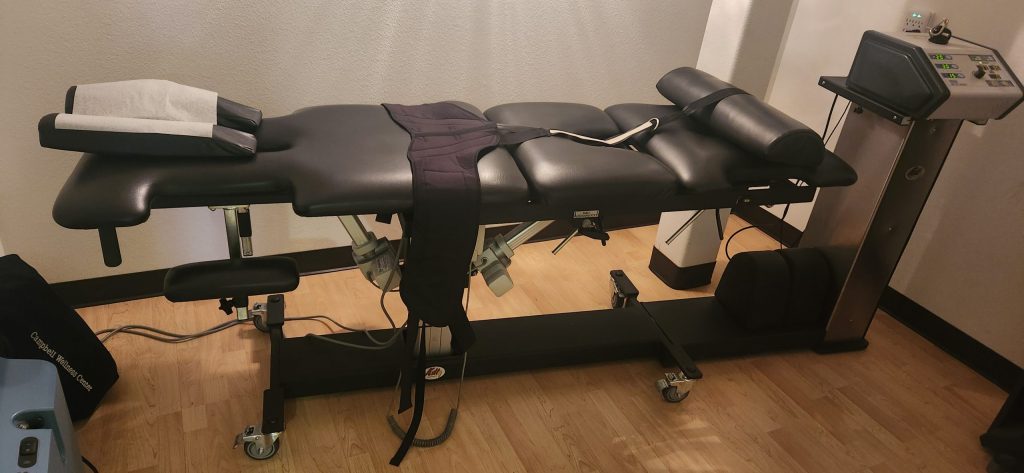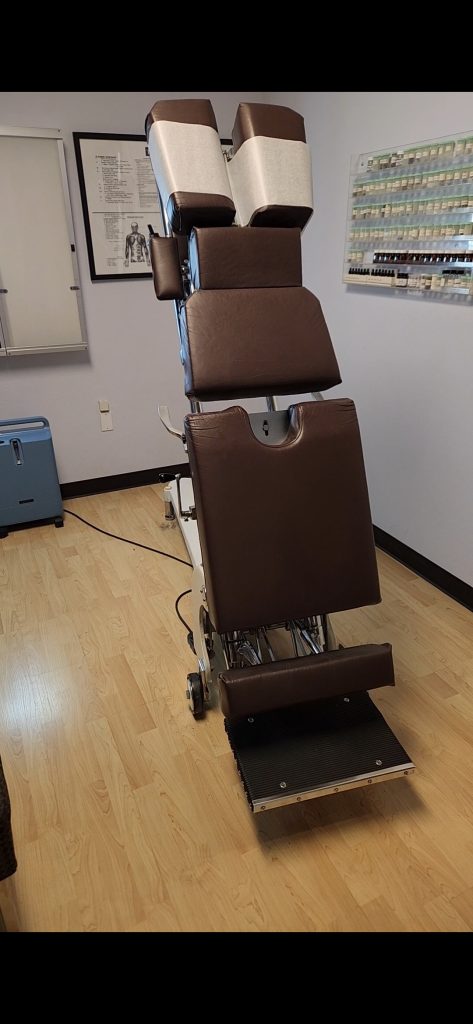
Millions of people struggle with back pain each year and seek relief through one of the most commonly discussed treatments: spinal decompression therapy or chiropractic adjustments. Both of these treatment modalities focus on the spine, but they use very different methods to reduce pain, enhance mobility, and encourage long-term healing.
If you’re still wondering whether spinal decompression or chiropractic adjustments are the best choice for you, we’ll compare the two treatments below to explain how they work and which approach may work best for your situation.
What Is Spinal Decompression Therapy?
Spinal decompression therapy is a non-invasive treatment that targets compressed spinal discs. When your discs become compressed as a result of an injury, herniation, or other disc degeneration issues, they can pinch the nerves in your back, neck, and extremities, resulting in pain, tingling, numbness, or other symptoms.
Non-invasive decompression uses a motorized traction table to stretch the spine, relax the muscles, and change the force of gravity temporarily to reduce the pressure on the discs.
Specifically, it aims to:
- Create negative pressure inside the disc
- Promote retraction of bulging or herniated discs
- Improve circulation of oxygen, nutrients, and hydration to damaged areas
- Stimulate natural healing and reduce pain
Sessions last between 20–45 minutes each, with 15–30 total sessions for most patients, depending on the condition’s severity.
Conditions Commonly Treated with Spinal Decompression
Patients with herniated or bulging discs, degenerative disc disease, sciatica or nerve compression, facet joint syndrome, chronic neck or lower back pain, or post-surgical spinal pain (in certain cases) often find relief with spinal decompression.
It can also be an effective way to reduce the need for surgery or opioids and heavy prescription painkillers in patients with disc degeneration.
What Is a Chiropractic Adjustment?

A chiropractic adjustment, sometimes called spinal manipulation, is a hands-on treatment that chiropractors use to restore spinal alignment, joint mobility, and overall body balance. The chiropractor uses their hands, mechanical pressure, or specially-designed tools to apply a precise, high-force impulse to a single vertebra or spinal joint that has become limited in motion.
A chiropractor may also employ other therapies and techniques, like heat therapy, stretching, exercise, ultrasound, cold laser therapy, or rehabilitative exercise.
A chiropractic adjustment’s goals include:
- Correcting spinal misalignments (called subluxations)
- Reduce nerve interference
- Improve joint mobility and function
- Reduce muscle tension
- Help restore the nervous system’s balance
A chiropractic adjustment is quite different from a spinal decompression treatment, which is more focused on relieving disc pressure and decompressing the spine.
Conditions Commonly Treated with Chiropractic Adjustments
Chiropractic care and adjustments are effective for back pain, neck pain and stiffness, headaches and migraines, whiplash and other soft tissue injuries, postural issues, joint pain, and more.
Regular chiropractic adjustments can improve athletic performance, reduce stress, enhance overall wellness, and even help the body heal from injury and disease.
The Main Differences Between Spinal Decompression and Chiropractic Adjustments
Both decompression and adjustments are effective in treating certain types of pain and other related issues, but each is different in the way it approaches spinal care and treatment. Here are the most important features to compare when evaluating your treatment options.
Feature Spinal Decompression Chiropractic Adjustment
- Goal – Relieve pressure on discs and nerves Restore proper alignment and mobility
- Method – Mechanical traction, gently stretching the spine Manual manipulation with controlled force
- Equipment – Motorized decompression table Hands, handheld adjusting tools
- Focus Area – Spinal discs and nerve roots Spinal joints, vertebrae, and nervous system
- Indications for Herniated discs, sciatica, chronic compression injuries Misalignments, stiffness, muscle tension
- Duration 20–45 minutes per session 5–15 minutes per session
- Pain Relief Takes effect over a few sessions. Fast relief after adjustment, but longer-term benefits take time
- Frequency 2–3x per week initially 1–2x per week or as needed
It’s important to note that both types of treatment are often complementary to one another. In other words, they frequently go hand-in-hand with patients benefiting from both therapies as part of an integrated approach to care.
Should You Get Spinal Decompression or Chiropractic Adjustments?
Determining which of these two treatments is right for you will depend on the cause of your pain, your medical history, and the goals you have for treatment.
Consider Spinal Decompression Therapy If:
- You suffer from chronic disc-related pain (bulging discs, herniated discs, etc.)
- You experience sciatica or nerve compression symptoms (numbness, tingling, or radiating pain)
- You are seeking a non-surgical treatment for disc issues
- You have tried other treatments but are still experiencing lower back or neck pain
Spinal decompression is an excellent choice for patients who want to experience relief gradually with minimal risk and long-term disc healing.
Consider Chiropractic Adjustments If:
- You are experiencing acute or chronic back or neck pain due to strain, poor posture, or misalignment
- You have stiffness or loss of mobility in your spine, neck, or joints
- You want to restore body balance and improve nervous system function
- You’re looking for a natural treatment to reduce tension and enhance your mobility
Choose chiropractic adjustments for quick relief from stiffness, pain, and limited mobility in your joints and spine. It often works well in combination with stretching, exercise, or other complementary therapies.
Combining Spinal Decompression Therapy and Chiropractic Adjustments
It is possible to receive both treatments, as many chiropractic offices offer spinal decompression along with manual adjustments.
The doctor may use the decompression treatment first to gently decompress the spine and then use a manual spinal adjustment to restore alignment and function. Combining both approaches:
- Gives you fast pain relief
- Enhances spinal mobility
- Promotes long-term healing
- Helps to prevent future flare-ups
Chiropractors and physical therapists often use the treatments as an effective one-two punch for chronic back pain, herniated discs, or other degenerative spinal conditions.
Why You Should Choose Professional Spinal Care
As long as you visit a licensed, experienced professional chiropractor, both spinal decompression and chiropractic adjustments offer numerous health benefits, including:
- Reduced inflammation and pain
- Improved posture and spinal mobility
- Increased circulation and nutrient delivery to the discs
- Reduced muscle tension and stress
- Long-term spinal health and wellness
When to Avoid Chiropractic and Spinal Decompression Treatments
Most people can benefit from either treatment or safely receive both, but chiropractic adjustments aren’t recommended for those with:
- Acute fractures or broken bones
- Inflammatory arthritis or joint disease
- Bone cancers or tumors
- Osteoporosis or bone degeneration
- Severe neurological problems
- Infection
Additionally, you should not receive spinal decompression therapy if you have:
- Metal implants in your spine
- Certain types of cancer
- Severe osteoporosis
- Recent abdominal or chest surgery
In all other cases, spinal decompression and chiropractic adjustments are safe, non-invasive, effective, and drug-free treatments that most people can safely use.
Schedule a Consultation to Learn More
Our chiropractors in Las Vegas, Nevada at Campbell Chiropractic and Wellness Center can help you learn more about spinal decompression therapy and chiropractic adjustments. We offer both as well as Hyperbaric Oxygen Treatment, Kinesiology treatment, Cold Laser Therapy, vitamin supplements, and more, providing the most advanced treatments to help you find relief. Schedule a consultation today by calling 702-734-8844 to learn more.